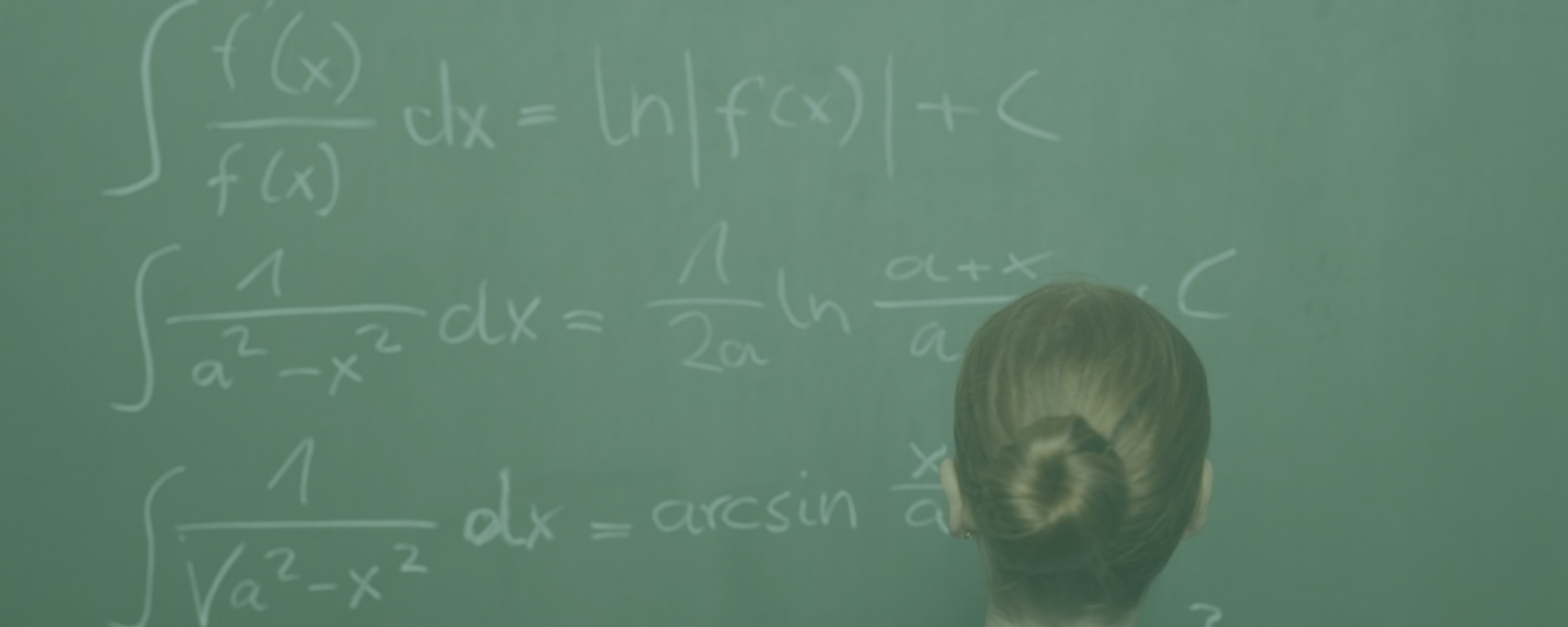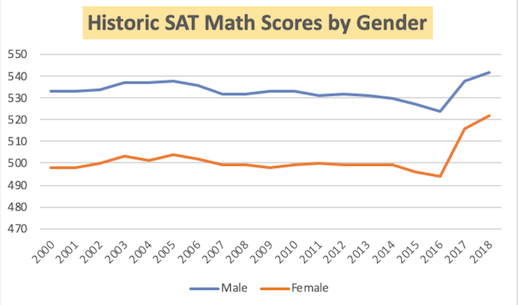Gender Gap Persists In ACT/SAT Math Scores
by Valerie Erde & Vickie Barone
Before we get to the post about the gender gap in math standardized test scores, I’d like to share a story about one of our female math students for inspiration and to demonstrate what is possible.
"When students ask for math tutoring early, they can get amazing results. One student approached me in December of her sophomore year. She was struggling in Algebra 2, getting a C when she was used to A's. She was frustrated and had lost confidence in her math abilities. We worked together regularly until the end of her senior year, building her confidence along with her skills. She got a 4 on her AP exam, and she was off to college equipped with the knowledge that she is capable of overcoming the academic struggles she might face in the future. Sometimes all it takes is a little personalized help!
I was thrilled for her when she wrote me this message:
Year after year, I read the reports from The College Board and the ACT.org — it’s my job, after all. And each year, I’m faced with new information about how girls’ standardized testing math scores lag those of their male peers, even though girls are earning higher grades than boys in virtually every high school subject.
According to the 2014 Research & Policy division of ACT Inc, female students earn on average 0.11 more GPA points than male students in math, and 0.13 more GPA points in science. Nevertheless, male students score an average of 0.86 points higher on the math portion of the ACT and 0.77 points higher on the science portion. And here’s how it looks for the SAT. (That upward spike for both males and females in 2016 was because of the global change to the SAT test format.)
The ACT’s 2018 Profile Report shows a slight improvement, with boys scoring 0.7 points higher on math and only 0.3 points higher on the science portion: but still, the difference doesn’t add up! Average SAT math scores show the same trend:
What’s going on here?
Differences In Spatial Visualization May Play a Role
Spatial visualization is the ability to imagine objects in your mind’s eye and rotate them in space. It’s essentially 3D thinking. This is the skill that helps you pack your car efficiently before a long road trip, and it’s crucial for problem solving in many STEM fields. In general, research shows that boys are better at this than girls even at a young age, and this could give boys a leg up on solving complex math problems when they’re older.
The reasons behind this difference aren’t at all clear, however. Some scientists suggest evolution, others a hormonal connection, and still others believe differences are socialized—meaning that gender expectations include the type of toys, play, or enrichment activities that would give boys an edge in developing this talent.
It’s also important to point out that these differences aren’t a life sentence. One interesting study found that college women made major improvements to their spatial visualization abilities by playing Tetris regularly, which suggests that spatial visualization can be learned at any age, by any gender.
Math Gender Gap Grows As Students Mature
Despite differences in spatial visualization, young children tend to score similarly on math assessments in elementary school. It’s only in high school and college that notable differences in math achievement arise. It’s not until high school that we see girls doing better on math classwork than boys, while boys perform better on tests that aren’t directly tied to classroom learning. For example, the SAT is quite unlike the work being done in most math classes, and boys do better on this assessment. The gap tends to narrow on state achievement tests, which are more closely tied to the curriculum. When it comes to teacher-made tests and classroom activities, girls do better overall.
These differences become more pronounced as students age and the math gets more challenging, particularly in the area of problem-solving. Gender differences in math performance are also more pronounced in high-achieving groups. That is to say, the difference between boys’ and girls’ test scores at the Honors or AP level is likely to be greater than the difference between boys’ and girls’ scores at the general or college preparatory level. This is particularly frustrating, because super-smart girls shouldn’t be lagging the boys in their college exam scores when they are clearly capable of high achievement.
This plays out in a disturbing way on the new SAT. Art Sawyer of Compass Education has studied the new SAT vs. the old version of the test, and he has determined that the gender gap for the top scorers has actually increased. According to his work, 45% more men than women score in the top range (1400-1600) of the SAT—up from 31% more men on the old SAT. This is exacerbated by the fact that math is now 50% of the total SAT score, with the other half being Evidence-Based Reading and Writing. When Reading and Writing were separate sections, math was only 33% of the total score, which appears to have helped more girls get into the top spots.
New SAT has exacerbated male/female math score gap. (Data and image by Compass Education Group.)
Old Societal Stereotypes Persist
If you ask the average person whether boys or girls are better at math, they’ll likely say boys—despite the GPA data cited above. Muriel Niederle and Lise Vesterlund, economists from Stanford University and the University of Pittsburgh, respectively, surmise that parents are often partly responsible for perpetuating stereotypes about male superiority in math. They write that “These perceptions were shown to be particularly important for a child’s confidence because a child’s self-evaluation of academic competency appears to be more strongly related to their parents’ appraisals of their academic ability than to their actual academic performance.” If girls are hearing subtle messages that show their parents don’t expect them to be good at math, the result can be a self-fulfilling prophecy.
Likewise, math anxiety is a pervasive issue in our society, and it’s not only about standardized tests. Researchers have explored how math anxiety affects people, even in “mundane everyday math tasks like calculating a tip at a restaurant or deciding whether or not they received the proper change at the grocery store.” The same researchers posit that female elementary school teachers may unwittingly pass their math anxiety on to young girls, not only causing them to “learn less math across the school-year” but also to absorb those negative stereotypes. The result? A cohort of girls with math anxiety that causes them to fall behind in timed, high-pressure mathematical scenarios. The one-two punch of anxiety about math and ingrained expectations may lead to a vicious, but largely hidden, cycle.
How can we help girls reach their full math potential?
Math Skills Build On Each Other, So Get Help Early!
Even if your daughter isn’t struggling in math class in school, it’s important to get help quickly. Math is a highly scaffolded subject, meaning that concepts learned in October will be built upon in December, March, and May. If foundational learning is shaky, things will only get harder. Most students find math challenging at some point during high school, and learning to ask for help now will be a great skill to take to college.
Girls Who Fear Math May Prefer the ACT
As for testing, high-performing teen girls who are generally stronger in language arts than in math may prefer the ACT over the SAT. That’s because math comprises only 25% of the composite score on the ACT, while it represents 50% of the total score on the SAT. Furthermore, since the ACT science section of the ACT is more like a STEM reading section than an actual STEM knowledge test, their skills may really shine on the ACT. But you’ll want to do an ACT vs. SAT diagnostic early on to see which test is better fit across sections.
Building Skills & Confidence With Great Resources
If you’re concerned about your daughter performing well in her academic math classes, or on the math section of the SAT or ACT, there are many great free and low-cost print and online resources. The Khan Academy, for example, provides excellent free support for all levels of high school math and science. Private tutoring can add a targeted and personalized approach to help your daughters (or sons) build skills as well as confidence in their abilities so they can perform their best on test day. Get in touch to learn more. (And here is the link to our star math tutor Vickie Barone’s post on VeridianPrep’s preferred ACT/SAT math prep books.
Additional Reading
Highest Performing Women Still Scoring Lower Than Men, Ms. Magazine, 2018.
“Improving adolescents’ standardized test performance: An intervention to reduce the effects of stereotype threat.” https://research.steinhardt.nyu.edu/scmsAdmin/uploads/004/309/Good%20Aronson%20Inzlicht.pdf
“Spatial Ability as a Mediator of Gender Differences on Mathematics Tests: A Biological-Environmental Framework.” https://psycnet.apa.org/record/2005-04568-006
“Nurture affects gender differences in spatial abilities.” https://www.pnas.org/content/108/36/14786.short




